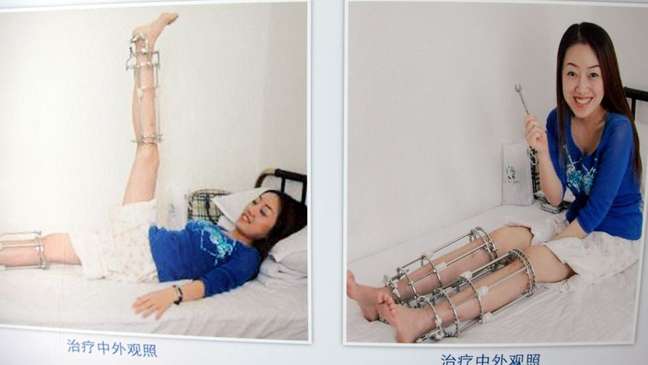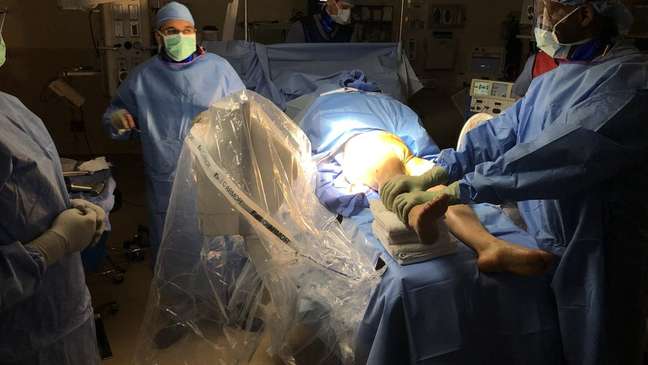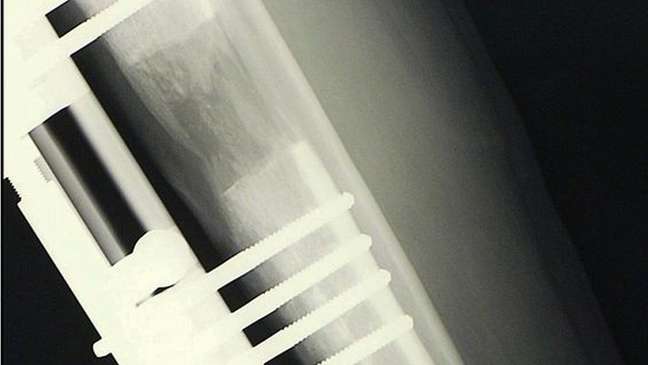More and more men are trying to gain a few inches of height with surgery that includes breaking the bone and can cost around R $ 370,000

“Women generally don’t date men shorter than themselves. Sometimes the hardest thing was feeling like I wasn’t going to find a wife.”
The phrase comes from Sam, a 30-year-old British man who has bet on a cosmetic surgery trend for men in countries like the United States, the United Kingdom, and even Spain: leg lengthening to increase height. The invasive operation consists in breaking the femur to gain a few centimetres.
Sam points out that, thanks to an operation, he has gained 8 centimeters in height and has gone from 1.62 meters to 1.70 meters in just a few months.
“I’ve always thought that being tall and being successful were interrelated factors. That’s why I had to find my own solution,” he told the BBC.
The operation requires weeks of convalescence and a recovery process during which the patient cannot even walk for months.
But that’s not all: in some cases men pay around US$70,000 (roughly R$370,000) to gain a few inches of height.
“It’s a painful operation, involving a long recovery process because part of the bone is soft, so you have to wait to walk until that bone can support body weight again,” surgeon Kevin Mundo told BBC Mundo. Debiparshad.
Debiparshad performs up to 50 such surgeries a month at his Las Vegas office, called the LimbplastX Institute, where he says he’s noticed an increase in demand from male patients.

“The taboo that men don’t get cosmetic surgery is fading. This operation in particular is what many men seek out,” says Debiparshad.
But it wasn’t always like this. For years, especially in eastern countries such as China, many women have turned to this type of surgery. Now, in Western countries, the numbers indicate that this phenomenon is growing among men.
Dispute
The operation is controversial.
Both the American Association of Plastic Surgeons and the American Academy of Orthopedists emphasize that leg lengthening surgery is an orthopedic procedure for cosmetic purposes.
The pioneer of this technique was a Soviet orthopedic surgeon who innovated rehabilitation treatments for soldiers maimed during World War II.
His name was Gavril Ilizarov, a doctor who during his stay on the battlefield noticed, together with the experiments he had made during his student years, that bones, especially the femur, tended to expand and “fill” the space between two bone. when he suffered a fracture.

Thus Ilizarov developed a technique which consisted in breaking the bone, but without compromising the part known as the periosteum (which is the external part of the bone), separating it a little and waiting for the bone itself to take care of occupying the remaining space in the bone.
“This technique has evolved a lot, but in reality the initial idea is the same: what we do is make sure that the bone itself fills that space and that’s where we gain the extra centimeters that the patient wants”, explains Debiparshad.
As explained by several surgeons consulted by the BBC, the standard treatment is as follows: first a hole is made in the leg bones, which are then split in two.
Then a metal rod is surgically inserted into the bone and held in place by a set of screws.
The rod is slowly lengthened up to 1 millimeter per day, until the patient reaches the desired height and his bones are allowed to heal again.
The procedure is painful and the recovery time is long.
“At my first appointment, the doctor made it clear to me how difficult the surgery would be. I was worried about what I might do after I had those extra inches. Will I still be able to walk? Will I still be able to run?” said Sam, the English patient.
Sam says he did physical therapy a few hours a day, three or four times a week, for six months.
“It was a very humbling experience. It’s kind of crazy… It’s like having new legs and learning to walk again. It just feels like plastic surgery, but it affected my mental health so much more,” she says. .

the risks
This is one of the aspects that most draws the attention of the medical community when it comes to this intervention: the risks of undergoing such an invasive procedure for aesthetic purposes.
Some experts warn of possible complications, from nerve damage and arterial embolisms to the possibility that bones won’t fuse back together.
“Techniques and technology have improved dramatically over the past two decades, making it a safer procedure. However, in addition to the bones needing to grow, more muscles, nerves and blood vessels also need to grow. The procedure remains extremely complex,” Hamish Simpson, an orthopedic surgeon, he told the BBC.
And it’s not just a physical problem. Experts warn of psychological risks that need to be considered, such as the fact that some of these patients may have body dysmorphia.
And this leads them, according to experts, to favor surgery to the detriment of physical and mental well-being.

“Faced with the dilemma of choosing a place with surgical expertise in these types of operations or a place to perform the procedure without breaking the bank, I don’t think people are necessarily aware of all the things that can and do go wrong,” he said on the BBC David Goodier, British orthopedic surgeon.
“And because many times these operations are done out of the country, the ones who end up facing these failures are the local doctors, who didn’t do the initial surgery,” Goodier says.
Debiparshad agrees that this is not a simple intervention and that it has several aspects that make it risky.
“We need high-tech equipment to reduce postoperative risks, but above all we make clear with patients the risks of the operation and that the recovery process will be very slow,” says the surgeon.
“We also offer postoperative support to people undergoing this surgery to ensure the success of the procedure,” he adds.
Increasing trend among men
But what is undeniable is that leg lengthening is an operation that men are increasingly seeking to gain a few centimetres.
Consultations from the BBC, clinics in the US, Canada, Spain and the UK confirmed that there has been an increase in the number of men requesting the procedure.
Debipashard says requests of this type have doubled in the past three years.
“What I hear from my male patients is that they’ve lost their fear of having this type of surgery and believe it can help them improve their self-confidence,” she notes.
Social pressure is one of the factors influencing the decision of men. Data from Forbes magazine suggests that the average height of the 500 richest people on the planet is 1.82 meters.
The American Association of Plastic Surgeons says that plastic surgery on men has increased by 30% over the previous decade.
But all the experts interviewed by the BBC issue the same warnings: it is a complex, expensive, high-risk operation with a long recovery process, which must be supervised by specialists.
– This text was published in http://bbc.co.uk/portuguese/geral-63761083
🇧🇷The best content in your email for free. Choose your favorite Terra newsletter. Click here!
Source: Terra
Ben Stock is a lifestyle journalist and author at Gossipify. He writes about topics such as health, wellness, travel, food and home decor. He provides practical advice and inspiration to improve well-being, keeps readers up to date with latest lifestyle news and trends, known for his engaging writing style, in-depth analysis and unique perspectives.







